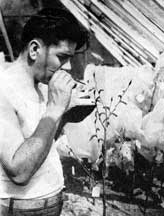New Trees For Our Forests
Producing hybrids with special qualities holds promise
By DOROTHY PARKER ROWE
Nature Magazine, August-September 1944
Foresters tell us we are cutting our trees faster than they grow. For example, many of the giant spruce trees leaving their forest home for airplane factories these days are fully 400 years old; and most of them are at least 200 years of age. That is a lot of growing time! At the present rate of lumber production, the supply of forest trees is constantly diminishing. What, therefore, is the answer?
Tree breeders believe one answer may be hybrid trees. (Yes, there are tree breeders, the same as animal breeders and plant breeders.) These tree scientists are beginning to roll up their sleeves. "You're doing a grand job of it," they are saying to Nature, "but Uncle Sam is using even more wood in this war than steel. We've got to grow trees faster."
Scientists claim that forest trees can be improved by hybridization, or crossbreeding, as agricultural and horticultural crops are improved. Hybrid corn, they point out, is a byword with farmers, and Luther Burbank's fast-growing cross between the California black walnut and the eastern black walnut is equally well known.

POLLEN BEING APPLIED TO FEMALE CATKINS ON HYBRID POPLAR BRANCHES
A tree breeder who has made a reputation for developing fast-growing hardwoods is Dr. Ernst J. Schreiner of the U. S. Forest Service. Actually, he calls himself a geneticist, because he investigates heredity and variation so as to know why individual trees resemble their parents or differ from them, and he determines how new strains can be developed. When he talks about his life work, he fairly bubbles over with optimism. He says that although the tree breeder has hardly scratched the surface, infinite possibilities lie ahead. As the tree wizard describes new hybrids he has created, the listener's imagination runs rampant, visualizing the magic hybridization can conjure with trees.
This sandy-haired scientist, although of youthful appearance, has had years and years of experience breeding trees. Twenty years ago when Dr. Schreiner began work, under the direction of Dr. A. B. Stout of the New York Botanical Garden, on a cooperative poplar breeding project financed by the Oxford Paper Company, no other large-scale program with the improvement of forest trees as its primary objective was underway in the United States, or, for that matter, anywhere in the world.
Dr. Schreiner became associated with the Forest Service in 1936, and ever since then he has been hybridizing poplars, birches, ash, maples, oaks, and other forest trees in the Northeast. Coincidentally, that same year the Oxford Paper Company turned over its hybrid stock and records to the Forest Service so that the new hybrid poplars could be tested further to find their place in our forest economy.
"The business of breeding forest trees is no picnic," Dr. Schreiner says, "what with the tree breeder having to double as aerial acrobat." If you picture the tree breeder as a staid somebody, safely transferring pollen from one flower to another within easy reach of the ground, you are definitely wrong except that forest trees do have flowers. But try and get to them. All too often they are, on the outside branches at the very top of the tree.
"Working with petunias or violets," Dr. Schreiner explained, "involves little physical effort; working with trees is a different story. Most people don't even realize trees have flowers, because, in most instances, the flowers are inconspicuous."
Sometimes, if the breeder is lucky, he can work the flowers from an ordinary stepladder. Then again, he has to use sectional stepladders that take him up thirty feet. When the flowers are beyond the reach of sectional ladders that can be carried readily, the resourceful tree breeder gets a bigger and heavier ladder, which he sets up on a truck. But many of the best "parent type" trees are unusually tall, and when the tree breeder runs out of ladders it is up to him to "play monkey" and climb the tree in order to carry on his work.
 Printer-friendly version
Printer-friendly version
